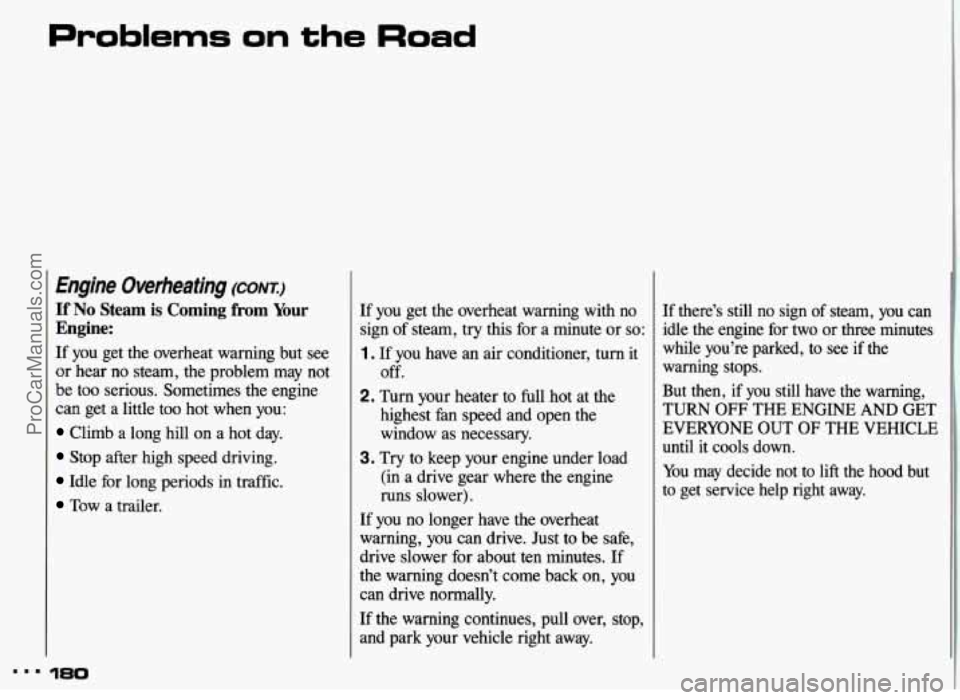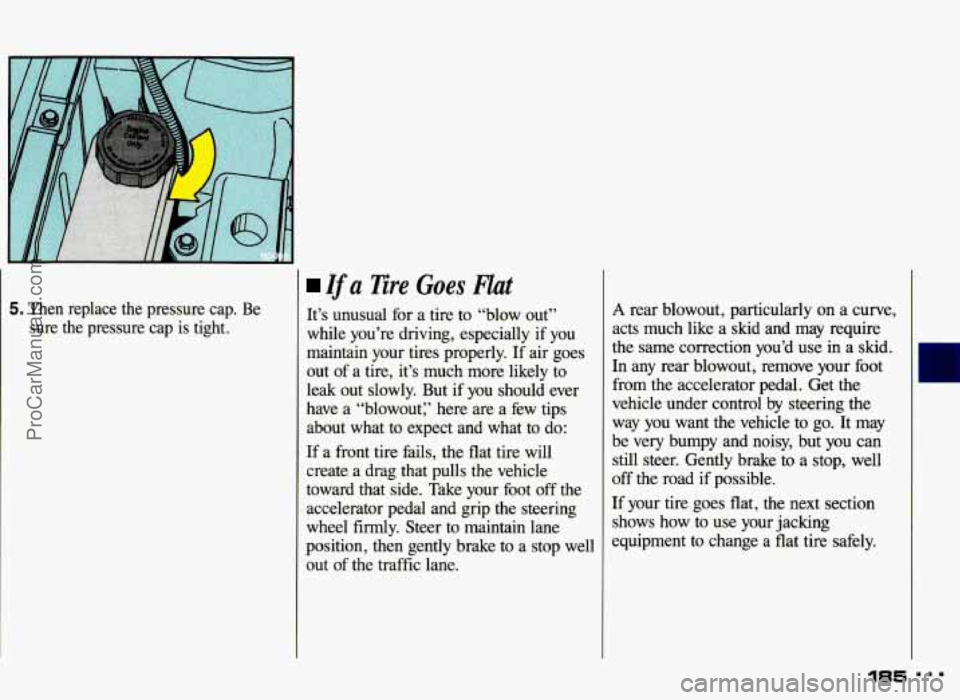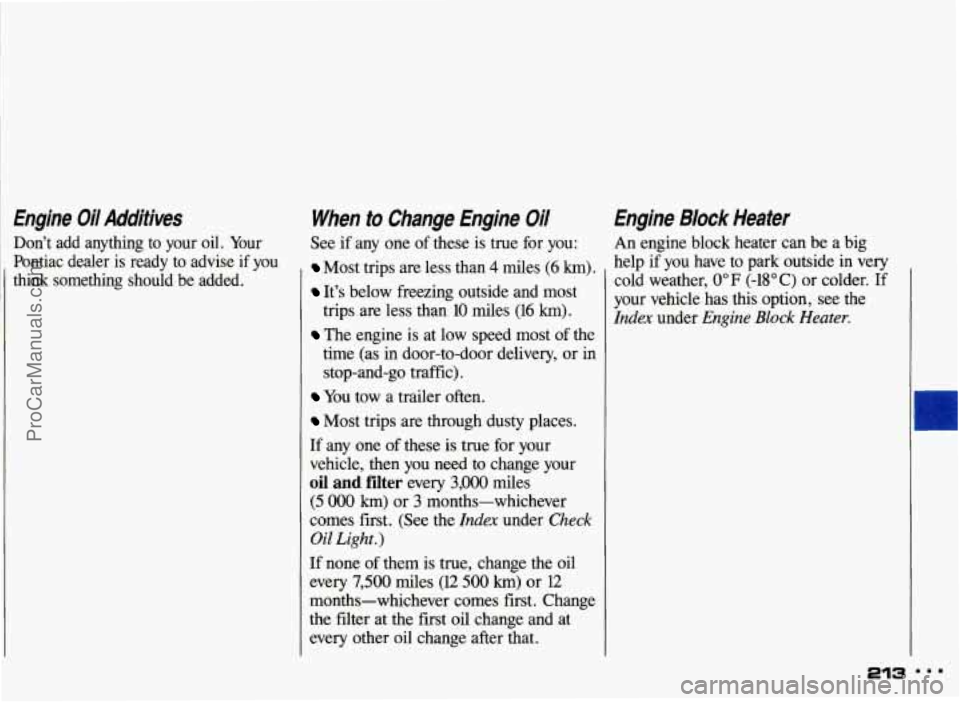Page 179 of 306
Problems on the Road
X5086
Towing from the Rear-
Vehide
Hook-Up
Before hooking up to a tow truck, be
sure to read all the information in
Towing bur Pontiac earlier in this
section. Also be sure to use the proper
hook-up for your particular vehicle.
Do not tow with sling-type
equipment or rear bumper valance
will be damaged. Use wheel-lift or
car carrier equipment (additional
ramping may be required for car
carrier equipment). Use safetv
chains and wheel straps.
1-
I
178
When using wheel-lift equipment,
towing over rough surfaces can
I
damage a vehicle. To help avoid
this, install a towing dolly beneath the wheels that would otherwise be
on the ground during the tow. This
will increase clearance between the
wheel-lift equipment and the
underbody of the towed vehicle. Attach
a separate safety chain to each
side
of the axle inboard of the spring.
ProCarManuals.com
Page 181 of 306

Problems on the Road
Engine Overheating (CONT)
If No Steam is Coming from Your
Engine:
If you get the overheat warning but see
or hear no steam, the problem may not
be
too serious. Sometimes the engine
can get a little too hot when you:
Climb a long hill on a hot day.
Stop after high speed driving.
Idle for long periods in traffic.
Tow a trailer.
180
If you get the overheat warning with no
sign of steam, try this for a minute or so:
1 . If you have an air conditioner, turn it
off.
2. Turn your heater to full hot at the
highest fan speed and open the window as necessary.
3. Try to keep your engine under load
(in a drive gear where the engine
runs slower).
If you no longer have the overheat
warning,
you can drive. Just to be safe,
drive slower for about ten minutes.
If
the warning doesn’t come back on, you
can drive normally.
If the warning continues, pull over, stop,
and park your vehicle right away. If there’s
still no sign of steam, you can
idle the engine for two or three minutes
while you’re parked, to
see if the
warning stops.
But then, if you still have the warning,
TURN
OFF THE ENGINE AND GET
EVERYONE OUT
OF THE VEHICLE
until it cools down.
You may decide not to lift the hood but
to get service help right away.
ProCarManuals.com
Page 186 of 306

5. Then replace the pressure cap. Be sure the pressure cap is tight.
Ifa 3iii.e Goes Hat
It’s unusual for a tire to “blow out”
while you’re driving, especially
if you
maintain your tires properly.
If air goes
out of a tire, it’s much more likely to
leak out slowly. But if you should ever
have a “blowout:’ here are
a few tips
about what to expect and what
to do:
If a front tire fails, the flat tire will
create a drag that pulls the vehicle
toward that side. Take your foot
off the
accelerator pedal and grip
the steering
wheel
firmly. Steer to maintain lane
position, then gently brake to a stop well
out of the traffic lane.
A rear blowout, particularly on a curve,
acts much like a skid and may require
the same correction you’d use in a skid.
In any rear blowout, remove your foot
from the accelerator pedal. Get the
vehicle under control by steering the
way
you want the vehicle to go. It may
be very bumpy and noisy, but you can
still steer. Gently brake to a stop, well
off the road
if possible.
If your tire goes flat, the next section
shows how to use your jacking
equipment to change a flat tire safely.
185 I I..
ProCarManuals.com
Page 191 of 306
Problems on the Road
F"
'hanging a Flat Tire (CONT.)
f A Rust or dirt on the wheel, or
L on the parts to which it is
fastened, can make the wheel nuts
become loose after a time, The
wheel could come off and cause an
accident. When you change a
wheel, remove any rust or dirt
from the places where the wheel
attaches to the vehicle. In an
emergency, you can use a cloth or
a paper towel to do this; but be
sure to use a scraper or wire brush
later, if you need to, to get all the
rust or dirt off.
9. Remove any rust or dirt from the
wheel bolts, mounting surfaces or
spare wheel.
mounting surface.
10. Place the spare on the wheel
Never use oil or grease on
e b studs or nuts. If you do, the
nuts might come loose. Your wheel
could fall off, causing a serious
accident.
I
1 1. Replace the wheel nuts with the
rounded end of the nuts toward the
wheel. Tighten each
nut by hand
until the wheel is held against the
hub
..I 190
ProCarManuals.com
Page 195 of 306
Problems on the Road
If Mu’re Stuck: In Sand, Mud,
Ice or Snow (CONXI
Spinning your wheels can dest
parts
of your vehicle as well as
tires.
If you spin the wheels too
fast while shifting your transaxle
back and forth,
your transaxle.
__
OY
194
Rocking Your Vehicle to Get it Out:
First, turn your steering wheel left and
right. That will clear the area around
your front wheels. Then shift back and
forth between
R (Reverse) and a
forward gear, or with a manual
transaxle, between
1 or 2 and R (Reverse),
spinning the wheels as little as possible.
Release the accelerator pedal while you
shift, and press lightly on the
accelerator pedal when the transaxle is
in gear. If that doesn’t get you out after a
few tries, you may need to be towed out.
If you do need to be towed out, see the
Index under Towing Your Pontiac.
ProCarManuals.com
Page 210 of 306
Engine Oil
It’s a good idea to check your engine oil
every time you get fuel. In order to get
an accurate reading, the
oil must be
warm and the vehicle must be
on level
ground. Turn
off the engine and give the
oil a few minutes to drain back into the
oil pan. If you don’t, the oil dipstick
might not show the actual level.
To Check Engine Oil:
Pull out the dipstick and clean it with a
paper towel or cloth, then push
it back
in all the way. Remove it again, keeping
the tip lower.
2.3L Quad OHC and Quad 4:
Checking Engine Oil
3300 V6: Checking Engine Oil
When to Add Oil:
If the oil is at or below the ADD line,
then
you’ll need to add some oil. But
you must use the right kind. This
section explains what kind
of oil to use.
For crankcase capacity, see the Index
under Capacities & Spec$kations.
20s
ProCarManuals.com
Page 214 of 306

I
Engine Oil Additives
Don't add anything to your oil. Your
Pontiac dealer is ready to advise
if you
think something should be added.
When to Change Engine Oil
See if any one of these is true for you:
Most trips are less than 4 miles (6 km).
It's below freezing outside and most
trips are less than
10 miles (16 km).
The engine is at low speed most of the
time
(as in door-to-door delivery, or in
stop-and-go traffic).
You tow a trailer often.
Most trips are through dusty places.
If any one of these is true for your
vehicle, then you need to change your
oil and fdter every 3,000 miles
(5 0oO km) or 3 months-whichever
comes first. (See the
Index under Check
Oil Light.)
If none of them is true, change the oil
every
7,500 miles (12 500 km) or 12
months-whichever comes first. Change
the filter at the first oil change and at
every other
oil change after that.
Engine Block Heater
An engine block heater can be a big
help if you have to park outside
in very
cold weather,
0" F (-18°C) or colder. If
your vehicle has this option, see the
Index under Engine Block Heater.
213 I..
ProCarManuals.com
Page 218 of 306

the transaxle fluid level if you have been
driving:
When outside temperatures are abve
At high speed for quite a while.
In heavy traffic-especially in hot
While pulling a trailer.
Ta get the right reading, the fluid should
be at normal operating temperature,
which
is 180°F to 200°F (82°C to
93°C).
Get the vehicle warmed up by driving
about 15 miles (24 km) when outside
temperatures are above 50°F (10°C). If
it’s colder
than 50°F (lO°C), you may
have to drive longer.
90°F (32°C).
weather.
0 Park your vehicle an a level place.
Place the shift lever in F (Park) with
With your foot on the brake pedal,
the parking brake applied.
move the shift lever through each gear
range,
pausing for about three seconds
in each range. Then, position the shift
lever
in P (Park).
five minutes.
Let the engine run at idle for three to
Then, Without Shutting OMF the
Engine, Follow These Steps:
1. Pull out the dipstick and wipe it with
a clean rag or paper towel.
2. Push it back in all the way, wait three
seconds and then pull
it back out
again.
3. Check both sides of the dipstick, and
read the luwer level. The fluid level
must be
in the crass-hatched area.
4. If the fluid level is where it should
be, push the dipstick back in all the
way.
ProCarManuals.com